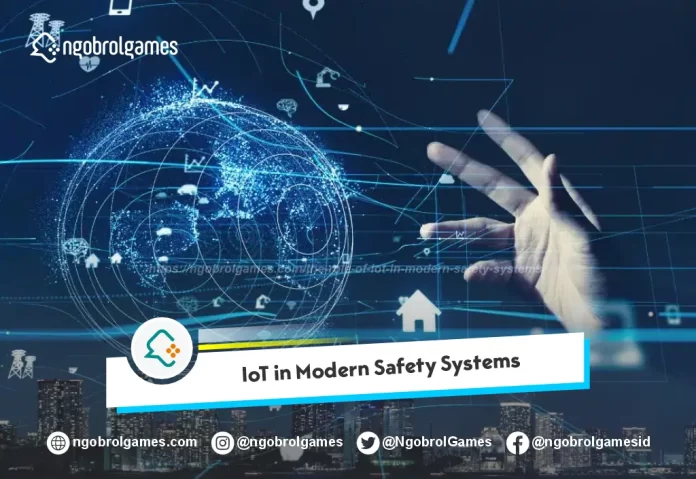Ngobrol Games – The Internet of Things (IoT) radically transforms security systems worldwide, establishing a new frontier where technology mitigates emerging threats swiftly and efficiently. As IoT technology proliferates, connecting billions of smart devices worldwide, it offers an unprecedented opportunity to strengthen security frameworks through seamless integration and interconnectivity.
By leveraging IoT security measures, organizations can transition from traditional safety models to advanced, technology-driven paradigms that align with the complexities of modern cyber landscapes.
Crucially, IoT enables robust, multilayered security management that transforms the dynamics of threat detection and response. Through its real-time data processing capabilities, IoT empowers organizations to foresee potential threats and respond with unparalleled agility and precision.
The ongoing expansion of IoT networks accentuates the need for robust security postures to shield against evolving vulnerabilities. As IoT redefines safety paradigms, it catalyzes vast opportunities for innovation and distinct challenges requiring strategic, forward-thinking solutions.
Benefits of IoT in Security
Integrating IoT technology into security infrastructures unveils transformative benefits, significantly enhancing the effectiveness and reliability of safety measures. The strategic deployment of intelligent sensors and crystal-clear surveillance devices allows for vigilant monitoring and rapid incident detection, creating a formidable defense that has the potential to neutralize threats before they escalate into full-blown crises.
Furthermore, integrating IoT with artificial intelligence magnifies its revolutionary impact on security. Advanced artificial intelligence algorithms can analyze extensive data produced by Internet of Things devices, enabling predictive threat evaluations and proactive risk management strategies.
This pivotal shift from reactive responses to anticipatory security management equips organizations with a comprehensive protective shield, fostering resilience in the face of emerging vulnerabilities. By harnessing these cutting-edge capabilities, organizations fortify their security frameworks and optimize their operational efficiency, carving a pathway toward a safer and more secure future.
Challenges in Securing IoT Devices
Despite the advantages, IoT adoption brings various security challenges that necessitate robust solutions. As these devices penetrate diverse domains—from smart homes to critical infrastructure—their appeal to cybercriminals intensifies. Many IoT devices operate on obsolete security protocols, leaving them susceptible to cyberattacks. According to recent studies, the frequency of IoT device hacking has climbed significantly, underscoring the urgent need for advanced security strategies that fortify against such threats.
A comprehensive strategy is essential to tackle these security challenges. Implementing stringent encryption standards to maintain data integrity throughout IoT networks is crucial. Continual monitoring and timely updates help maintain security while addressing vulnerabilities as they arise. Moreover, fostering a culture of security awareness is instrumental in protecting the expansive digital environment. Organizations must cultivate vigilance at every operational level to ensure robust defenses against a constantly shifting threat landscape.
Common Strategies for IoT Security
Implementing effective IoT security strategies is paramount to safeguarding the integrity of these intricate ecosystems. Advanced encryption technologies are critical in preserving data as they traverse complex networks, ensuring confidentiality and integrity. Network segmentation further enhances security by isolating different network parts, containing potential breaches, and preventing threats from spreading laterally.
Equally important is educating users on cybersecurity best practices. Awareness and knowledge constitute the first lines of defense, empowering individuals and organizations to identify and counteract potential threats. Regular software updates, timely patches, and rigorous IoT device management are indispensable components of a comprehensive security strategy. By instilling a culture where security is an intrinsic aspect of operations, organizations can strengthen their resilience against evolving cyber threats.
Case Studies: Effective IoT Security Solutions
Real-world case studies offer significant insights into the practical application of security measures for the Internet of Things (IoT). Organizations that adopt a multilayered approach often achieve the most effective security outcomes. These strategies typically involve combining traditional security practices with advanced IoT technologies, promoting a defense-in-depth strategy that ensures comprehensive protection.
Aligning their practices with the latest technological trends and threat intelligence can help organizations build resilient and proactive defenses capable of mitigating various threats. The emphasis on continuous improvement underscores the critical role of innovation in shaping the future of IoT security.
Future Trends in IoT Security
The future of IoT security stands at the brink of a transformative era, brimming with groundbreaking advancements and innovative technologies that are set to revolutionize protective strategies. Among these, blockchain technology emerges as a powerful ally, offering a decentralized and unalterable framework for verifying devices and managing their identities.
This system ensures that only trusted devices can join networks, acting as a formidable shield against unauthorized intrusions that threaten vital data and communication channels.
In addition to blockchain, machine learning is poised to become a cornerstone of future IoT security measures. Armed with predictive analytics, machine learning algorithms can spot anomalies and irregularities in real-time, empowering security systems to respond swiftly and effectively to potential threats.
With continuous advancements in industry standards and cutting-edge technological frameworks, the future of IoT security promises increased resilience and reliability, paving the way for a secure and interconnected world where our devices can communicate freely and safely.
Integrating IoT technology into security frameworks ushers in a transformative era with remarkable opportunities and daunting challenges. This evolution profoundly redefines our understanding of safety and resilience, reshaping how they are implemented.
Organizations can craft innovative strategies that unlock the full spectrum of these powerful technologies by adopting a holistic perspective that scrutinizes the myriad advantages and potential pitfalls of embracing IoT. With vigilant adaptation and unwavering commitment, they can foster secure and resilient environments, standing strong amidst the relentless tide of technological progress.

